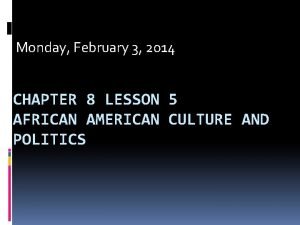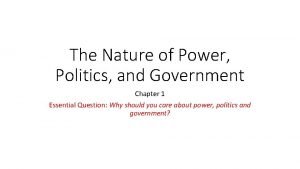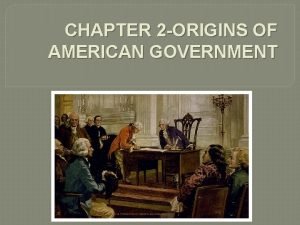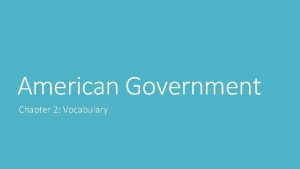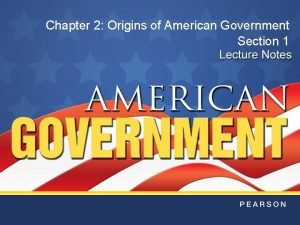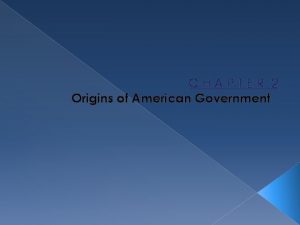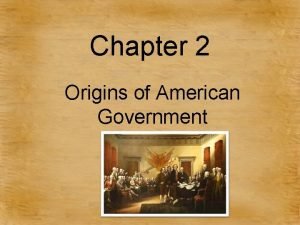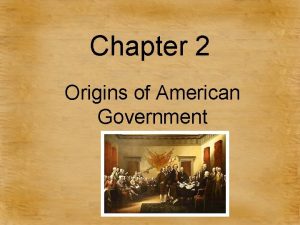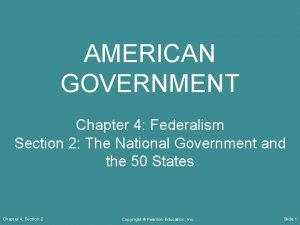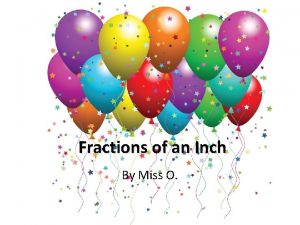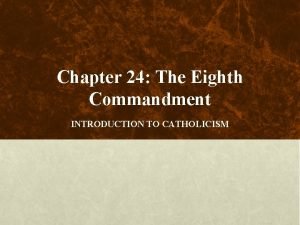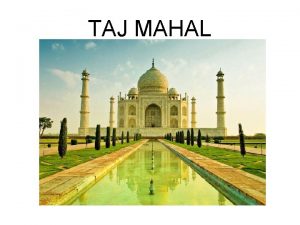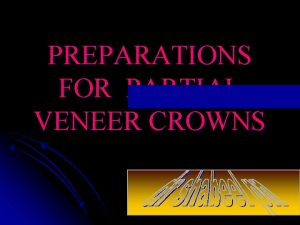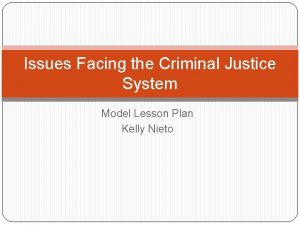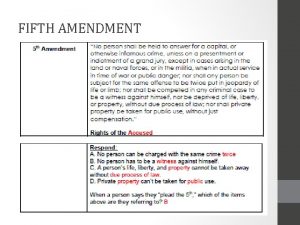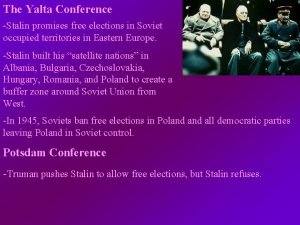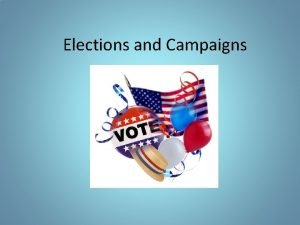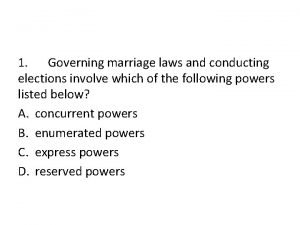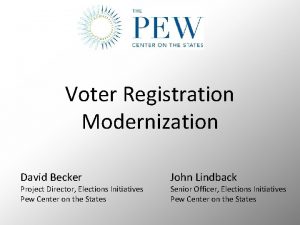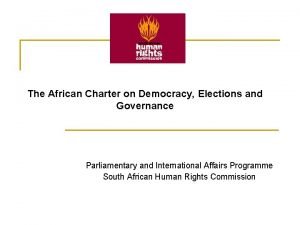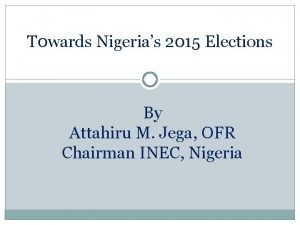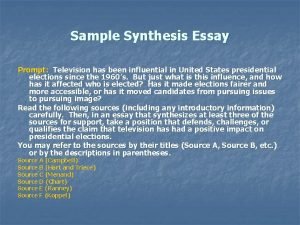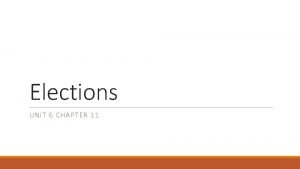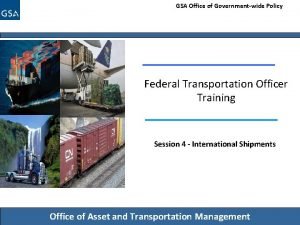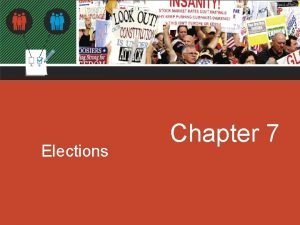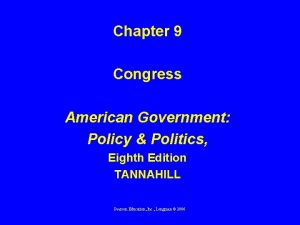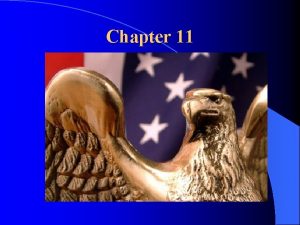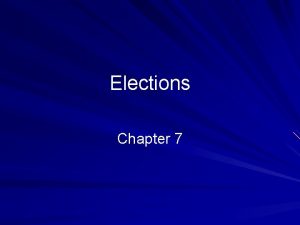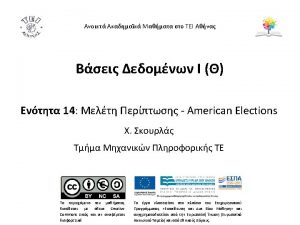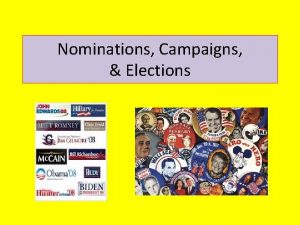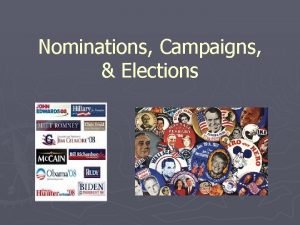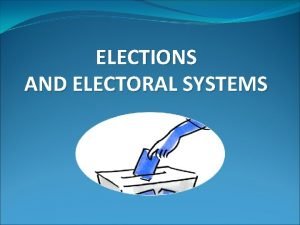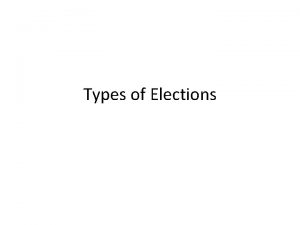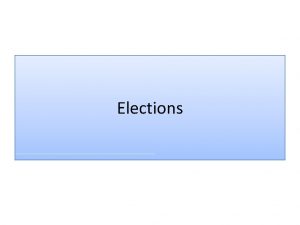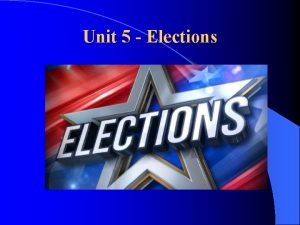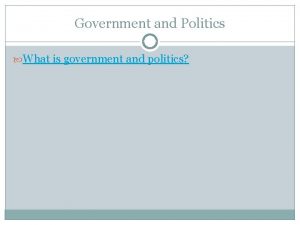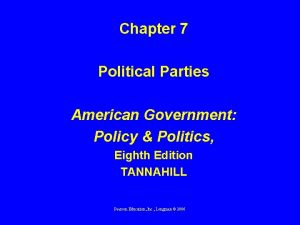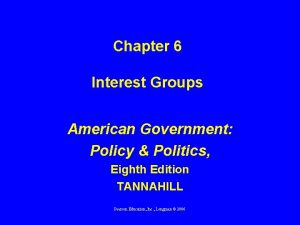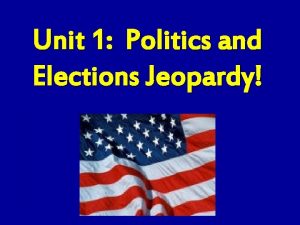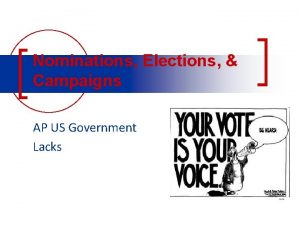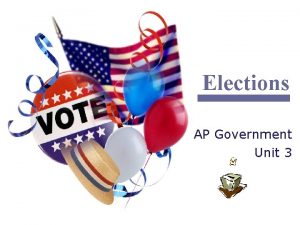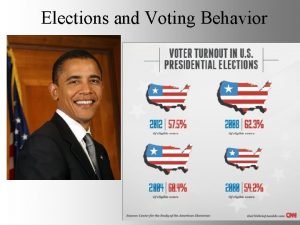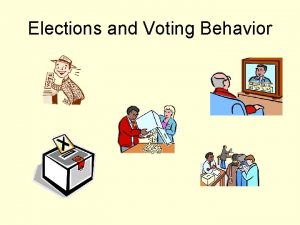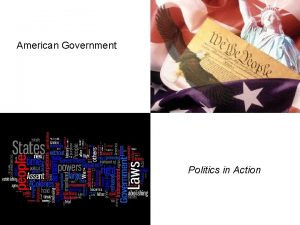Chapter 8 Elections American Government Policy Politics Eighth


































- Slides: 34

Chapter 8 Elections American Government: Policy & Politics, Eighth Edition TANNAHILL Pearson Education, Inc. , Longman © 2006

In This Chapter We Will Cover: • • • Types of elections Election districts and redistricting Election campaigns Congressional elections Presidential elections The voters decide Pearson Education, Inc. , Longman © 2006

Types of Elections • General elections fill state and national offices held in November of even-numbered years. – Split-ticket ballots involve voters casting ballots for the candidates of two or more political parties. – Straight-ticket ballots involve voters selecting the entire slate of candidates of one party only. • Runoff elections are between the two candidates receiving the most votes when no candidate got a majority in an initial election. Pearson Education, Inc. , Longman © 2006

Types of Elections • Primary elections are held to determine a party’s nominees for the general election ballot. – Closed primaries limit participation to registered party members. – Open primaries allow voters to pick the party primary of their choice without regard to their party affiliation. – All-party primaries allow all candidates for an office to compete with one another regardless of party affiliation. Pearson Education, Inc. , Longman © 2006

Election Districts • At-large elections – This is a method for choosing public officials in which the citizens of an entire political subdivision, such as a state, vote to select officeholders Pearson Education, Inc. , Longman © 2006

Election Districts • District elections – This is a method for choosing public officials that divides a political subdivision, such as a state, into geographic areas called districts and each district elects one officials Pearson Education, Inc. , Longman © 2006

Reapportionment • Apportionment is the allocation of legislative seats among the states. • Redistricting is the process through which the boundaries of legislative districts are redrawn to reflect population movement. Pearson Education, Inc. , Longman © 2006

Reapportionment • On person, one vote rulings like Baker v. Carr (1962) and Wesberry v. Sanders (1964) assert that the equal protection clause of the Fourteenth Amendment requires legislative districts be apportioned on the basis of population. Pearson Education, Inc. , Longman © 2006

The Voting Rights Act (VRA) • The VRA is a federal law designed to protect the voting rights of racial and ethnic minorities. – Pre-clearance state and local governments in areas with a history of voting discrimination must submit redistricting plans to the federal Department of Justice for approval before they go into effect. Pearson Education, Inc. , Longman © 2006

The Voting Rights Act (VRA) – Majority-minority districts are districts drawn in order to maximize the number of minorities and therefore influence electoral outcomes. Pearson Education, Inc. , Longman © 2006

Gerrymandering – Gerrymandering is the drawing of legislative district lines for political advantage. – Mid-Cycle Redistricting is the practice of redrawing legislative districts outside the regular redistricting cycle in order to gain political advantage (Texas and Colorado). Pearson Education, Inc. , Longman © 2006

Election Campaigns • The Cost of Campaigns – Major presidential candidates must raise a minimum of $30 -$40 million. – Incumbent U. S. House candidates spent $900, 000 running in 2002. • The Campaign Budget – The largest item in most campaign budgets is advertising, especially television. Pearson Education, Inc. , Longman © 2006

Funding • Sources of Campaign Money – Individuals – Interest groups – Political parties – Federal government – Themselves Pearson Education, Inc. , Longman © 2006

Funding • Campaign Finance Regulations and Reform – Soft money: Funds raised by political parties that are not subject to federal campaign finance regulations. – Independent expenditures: Funds spent on behalf of a particular candidate that are not coordinated by the candidate’s campaign. – Hard money: Funds that are subject to federal campaign contribution and expenditure limitations. – 2002 BCRA: Banned soft money contributions to the national party committees up to $10, 000. Soft money given to state committees could not be used for Congressional or Presidential elections. No issue advertisements 60 days before general election, or 30 days before primary. Pearson Education, Inc. , Longman © 2006

Campaign Organization and Strategy • Long, drawn-out affairs • Incumbents never really stop campaigning • Incumbent presidents and the “rose garden strategy” • Challengers build name recognition • Favorable image of the candidate and unfavorable image of their opponent • Focus groups • Sound bites Pearson Education, Inc. , Longman © 2006

Congressional Elections • House Elections – The incumbency advantage- The most striking feature of elections for the U. S. House of Representatives is that most incumbents are reelected. In 2004, only nine incumbents were defeated for reelection. Pearson Education, Inc. , Longman © 2006

Congressional Elections • Senate Races – More competitive than House races, the winning candidate in 14 of 34 Senate races in 2002 received less than 55 percent of the vote. – Incumbent senators generally face stronger challengers than House incumbents. Pearson Education, Inc. , Longman © 2006

Presidential Elections • The Presidential Nomination Phase – Candidates compete for their own political party’s nomination in a series of primaries, caucuses, state conventions, and finally the national nominating convention. • The delegate-selection process (primaries and caucuses) • Reforming the delegate-selection process Pearson Education, Inc. , Longman © 2006

The Road to the Nomination • Pre-primary positioning stage • Iowa and New Hampshire - narrowing the field • The March shootout • The transition • The national party conventions Pearson Education, Inc. , Longman © 2006

Pre-primary positioning stage • The candidate who is ahead in the polls and in funds before the start of an election year, usually wins nomination – Howard Dean was an exception • Raising funds – To accept federal matching funds or not Pearson Education, Inc. , Longman © 2006

Iowa-New Hampshire Narrowing the Field • Iowa: The first caucus • New Hampshire: The first primary • Both receive an abundance of media coverage • Doing well in these helps to raise funds • Eventual nominee is usually in the top three in Iowa and the top two in New Hampshire Pearson Education, Inc. , Longman © 2006

The March Shootout • Frontloading of the nomination process • By the end of March, the nominees of both parties are assured • GOP settled first because of “winnertake-all” delegate rule • Democrats award delegates on propotional basis Pearson Education, Inc. , Longman © 2006

The Transition • Early April to midsummer • Speeches focus on general election as opposed to addressing the “hard-core” party voters Pearson Education, Inc. , Longman © 2006

The National Party Conventions • Party platform: Statement of party principles and issue positions • Official selection of the presidential nominee • Balancing the ticket by the choice of vice president Pearson Education, Inc. , Longman © 2006

Presidential Elections • The General Election Phase – Candidates who have won their party’s nomination compete in the November election to try and win electoral votes from the states. To be elected president, a candidate must win a majority of the electoral votes. Pearson Education, Inc. , Longman © 2006

Popular Vote and Electoral Vote Percentages Pearson Education, Inc. , Longman © 2006

In the 2004 election, President Bush won reelection by capturing 31 states with 286 electoral votes Pearson Education, Inc. , Longman © 2006

The Voters Decide • • • Party identification Issues Personal Qualities and Image Campaigns Retrospective and Prospective Voting Pearson Education, Inc. , Longman © 2006

Party Identification • Voter choice closely follows party lines • Party identification based on shared perspectives on issues Pearson Education, Inc. , Longman © 2006

Issues • The majority of the electorate not fully informed of the candidate’s stand on issues • Low-information rationality - because most voters have a limited understanding of politics, they use informational shortcuts • Opinion leaders - individuals whose views help to shape the political attitudes of the public Pearson Education, Inc. , Longman © 2006

Personal Qualities and Image • Concept of what a president should be – Competent – Honest – Reliable – Moral leadership Pearson Education, Inc. , Longman © 2006

Campaigns • Without a funded campaign, there is no winning • Advertising • Base decides in advance of Election Day • National conditions affect voters’ choice Pearson Education, Inc. , Longman © 2006

Concluding Review Questions • What is the difference between general elections and primary elections? • What is the difference between at-large and district elections? • How does “one person, one vote” affect redistricting? Pearson Education, Inc. , Longman © 2006

Concluding Review Questions • How does the Voting Rights Act (VRA) affect redistricting? • What role does money play in the election process? • What impact will Mc. Cain-Feingold have on campaign financing? • To what extent do elections shape public policy? Pearson Education, Inc. , Longman © 2006
 Lesson 5 african american culture and politics
Lesson 5 african american culture and politics Chapter 20 whose government
Chapter 20 whose government Unit 1 intro to government review guide
Unit 1 intro to government review guide The nature of power politics and government
The nature of power politics and government Chapter 2 american government
Chapter 2 american government Origins of american government vocabulary
Origins of american government vocabulary Chapter 2 origins of american government answer key
Chapter 2 origins of american government answer key Chapter 2: origins of american government worksheet answers
Chapter 2: origins of american government worksheet answers Chapter 2 lesson 1 government in colonial america
Chapter 2 lesson 1 government in colonial america Chapter 2 origins of american government
Chapter 2 origins of american government American government chapter 4
American government chapter 4 Anagram of eighth
Anagram of eighth Psychology eighth edition david g myers
Psychology eighth edition david g myers Inner planets matching
Inner planets matching Nearest eighth of an inch
Nearest eighth of an inch Psychology eighth edition david g myers
Psychology eighth edition david g myers The fifth, sixth, seventh, and eighth amendments protect *
The fifth, sixth, seventh, and eighth amendments protect * 8th commandment catholic
8th commandment catholic Taj mahal 8th wonder of the world
Taj mahal 8th wonder of the world 3 quarter crown
3 quarter crown Eighth amendment excessive bail
Eighth amendment excessive bail Eighth letter of the alphabet
Eighth letter of the alphabet Eighth amendment excessive bail
Eighth amendment excessive bail 9th amendment meaning
9th amendment meaning Operations management eighth edition
Operations management eighth edition Stalin promise free elections
Stalin promise free elections Presidential elections exploration and announcement
Presidential elections exploration and announcement Governing marriage laws and conducting elections
Governing marriage laws and conducting elections David becker elections
David becker elections African charter on democracy, elections and governance
African charter on democracy, elections and governance Conclusion on elections
Conclusion on elections Ap lang synthesis essay television presidential elections
Ap lang synthesis essay television presidential elections “elections are key to democracy”
“elections are key to democracy” Office of government wide policy
Office of government wide policy Senior policy officer scottish government
Senior policy officer scottish government
